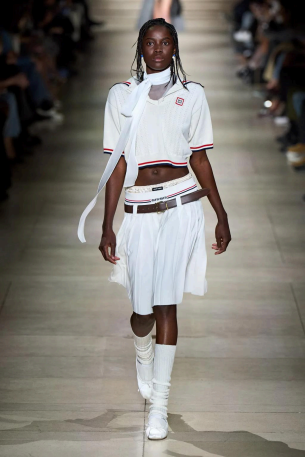If everyone is wearing black, I want to be wearing red.
When Maria Sharapova said that, she wasn’t just talking about a dress: she was talking about disruption. Tennis style once obeyed tradition; now, it rewrites the rules.
Maria Sharapova
From modest Victorian whites to catsuits, corsets to crop tops, tennis apparel has morphed from functional uniform to cultural statement. And today, athletes serve more than just aces. They serve identity, innovation, and influence.
Women archers competed at the London Olympics (1908)
Once, players wore high collars, long skirts, and tightly stitched decorum. The all-white code, especially at Wimbledon, stood for purity on the surface, anyway. But cracks appeared early. In 1919, Suzanne Lenglen shocked Wimbledon in a revolutionary Jean Patou–designed ensemble: a sleeveless, calf-length, pleated dress that shattered Edwardian norms and introduced athletic elegance to women’s tennis.
Suzanne Lenglen wearing Jean Patou’s groundbreaking tennis dress that redefined women’s sportswear (1919)
Fast-forward: Billie Jean King wore shorts, fought for pay equity, and founded the Women's Tennis Association (WTA). Andre Agassi donned neon Lycra, denim shorts, turning Centre Court into a runway. Nike paired him with the Red Hot Chili Peppers. Icon status? Secured.
Billie Jean King at the Wimbledon match (1973)
Andre Agassi in shorts at the US Open (1988)
Even Anne White’s all-white bodysuit at Wimbledon (1985) caused a stir. Because in tennis, changing clothes can still mean changing culture.
Anne White in all-white bodysuit at Wimbledon (1985)
Today, athletic wear isn’t just catching up. It’s leading. The 21st century turned tennis fashion into a playground of high-performance fabrics and high fashion.
Nike’s Dri-FIT, Adidas Climalite, and now biometric shirts or solar-powered gear are redefining function. Labs like Cornell’s Textile Nanotechnology Lab are engineering clothes that compute, adapt, and even heal.
Nike Dri-Fit Tennis Dress
Adidas Climalite Tennis Dress
With the global digital health market at $358.07 billion in 2023, projected to grow 9.3% annually through 2030, ethical fashion is no longer niche. Brands are racing to 3D print, waterlessly dye, and source biodegradable fabrics. Eco is in.
Tennis fashion has become a platform for activism. Serena Williams wore a black compression catsuit at the 2018 French Open to help prevent blood clots after childbirth, combining functionality with empowerment. The outfit sparked controversy after it was banned by the French Tennis Federation, igniting global debate about dress codes, gender, and race in sport.
Serena Williams in a black catsuit at the French Open (2018)
From Miu Miu Fall/Winter 2022/2023 to Miu Miu Spring/Summer 2025 and Chanel Resort 2023, tennis has become a couture canvas. Roland-Garros 2025 confirmed it: shorts and tees dominated at 64.3% each, dresses trailed at just 14.3%, and colors like #50161e (27.2%) and #cba9af: 19.8% led, giving the court a moody, Parisian edge.
Mirra Andreeva in the Nike Paris collection, but in a darker, burgundy hue at Roland-Garros match (2025)
Photo: Kazakhstan’s Puntiseva REUTERS/Denis Balibouse
Naomi Osaka’s sakura-themed look blended soft florals and pink hues with burgundy accents, down to every styled detail at Roland-Garros match (2025)
Miu Miu Fall/Winter 2022/2023
Miu Miu Spring/Summer 2025
Lacoste FW 2024, staged on an actual clay court, served a subversive remix of tenniscore. Think pleated skirts with attitude, layered scarves knotted like power moves, and sneakers that ground heritage in streetwear grit. One standout look paired an inky, high-collared blouse with a flowing asymmetrical skirt, striped belt, and color-popped necktie, quietly nodding to tennis tradition while rewriting it in fluent fashion-forward. It was preppy, polished, and a little rebellious.
Lacoste Fall-Winter 2024
Tennis fashion reflects society’s growing hunger for diversity, gender fluidity, and representation. Visibility of women and non-white athletes, new sizing standards, and looser codes show one thing: exclusivity is out; identity is in. And customization? It’s everything. Players are designing their own kits, aligning their on-court looks with off-court brands. Sneaker culture fuels limited-edition drops. Tennis has entered the fashion metaverse, and it’s thriving.
Smart apparel will soon track hydration, heart rate, even swing precision. Technology that blends in but elevates everything. Fashion becomes feedback.
Inclusive lines are rising too: adaptive tennis wear for all bodies, all abilities. Function no longer excludes style, and the court no longer excludes anyone.
From corsets to compression gear, catsuits to computing fabrics, tennis apparel has always mirrored something bigger: power, protest, progress. As tech and culture evolve, so does the game’s wardrobe. And whether you're serving or spectating, don’t just watch the match. Watch what it’s wearing.
XOXO, The Fashion Stock Market













